Progress
Neck fitted and ready for truss rod and fingerboard.
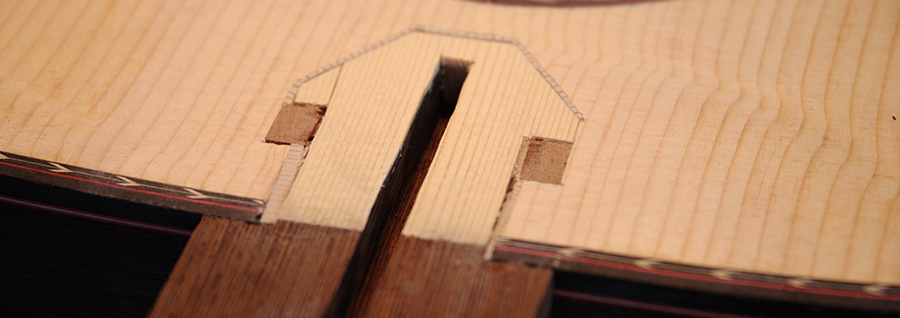
My next Steinbeck is well under way, the back, sides and soundboard built and assembled. Today I bound the body, and after trimming the binding I’ll be fitting the neck.
The top is Bearclaw Sitka, the back and sides are Malaysian Blackwood from Steve Keys’ Keystone site.
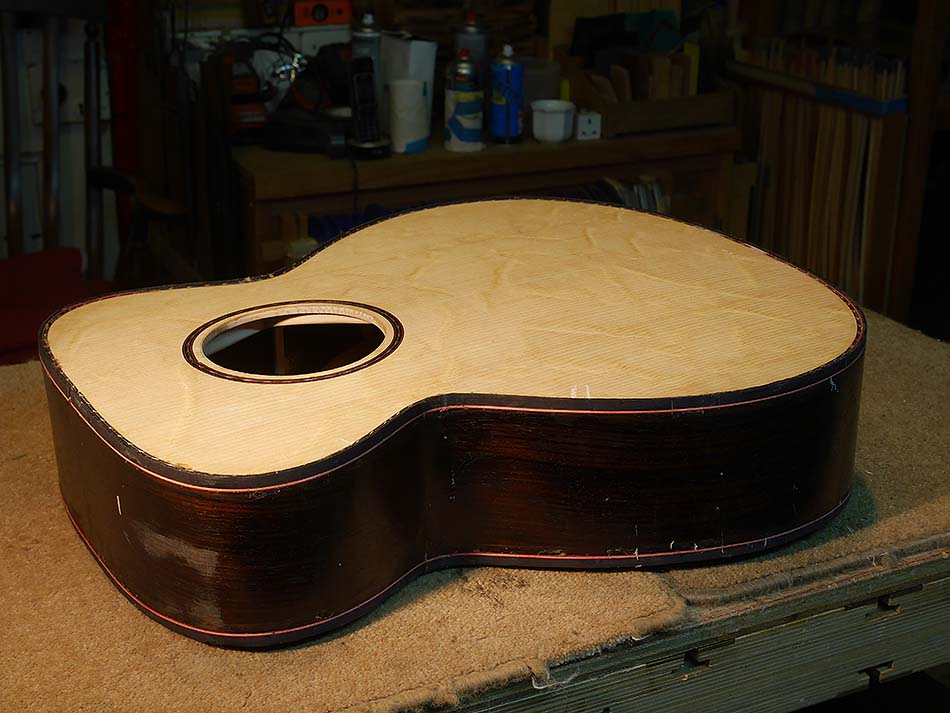
Binding ready to be scraped smooth. Note the soundboard bearclaw figuring.
Guitar headstocks are relatively easily cracked. This Model 3 (16 fret to the body) guitar belongs to Hajime Takahashi. He was in Limerick for a rehearsal, went to a restaurant in town, one of the staff offered to keep the instrument for him but knocked it and, as he put it, the head got smashed.
It was the most common damage, just where the head joins the neck. The head wasn’t right off, but was cracked most of the way through.
Gluing and clamping the crack closed was not difficult. At this point it would have been possible to sand the area clean and re-finish; glued cracks like this can be very unobtrusive. But they are also vulnerable to cracking again, usually not in exactly the same place, but a couple of millimetres away from the previous crack.
So having glued the crack, I did more. I shaved four millimetres from the back of the headstock, and tapered this to nothing about a third of the way up the neck. Then I bent a piece of four millimetre thick mahogany (matching this as closely as possible to the original wood) so that it had the correct bend to match the angle of the head to the neck.
I glued this to the neck, clamping hard, and left it overnight to dry. Next day I was able to shape the added wood to match the original neck.
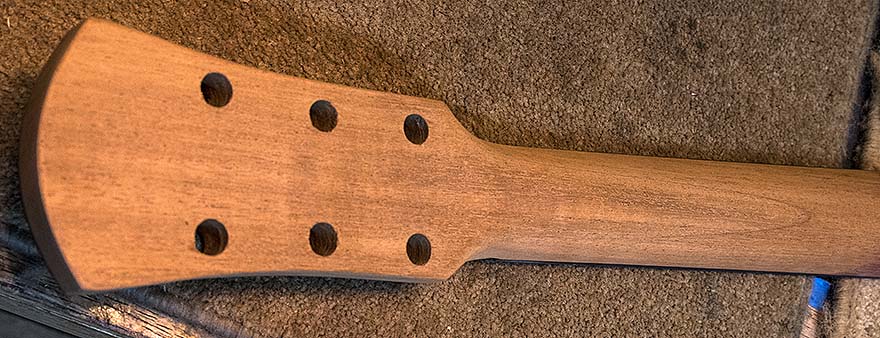
Here the new wood is glued, is shaped to the original neck profile, and the tuner holes drilled through it. The join can be seen best where the new wood feathers into the original wood on the right of the picture.
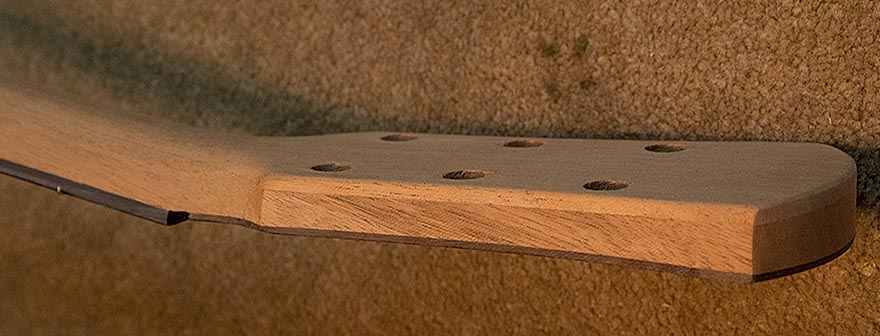
The layer of new wood is clearly visible from the side, mainly because of the different grain direction.
So now there is a layer of solid wood three to four millimetres thick covering the repaired crack, with continuous grain along its length. This gives the repair great strength.
Next the guitar goes to Dave Wilson who will re-lacquer the neck.
Thank you to all who enquired as to the condition of my damaged finger. Amazing how fast news travels. Happy to report said finger is now fully healed.
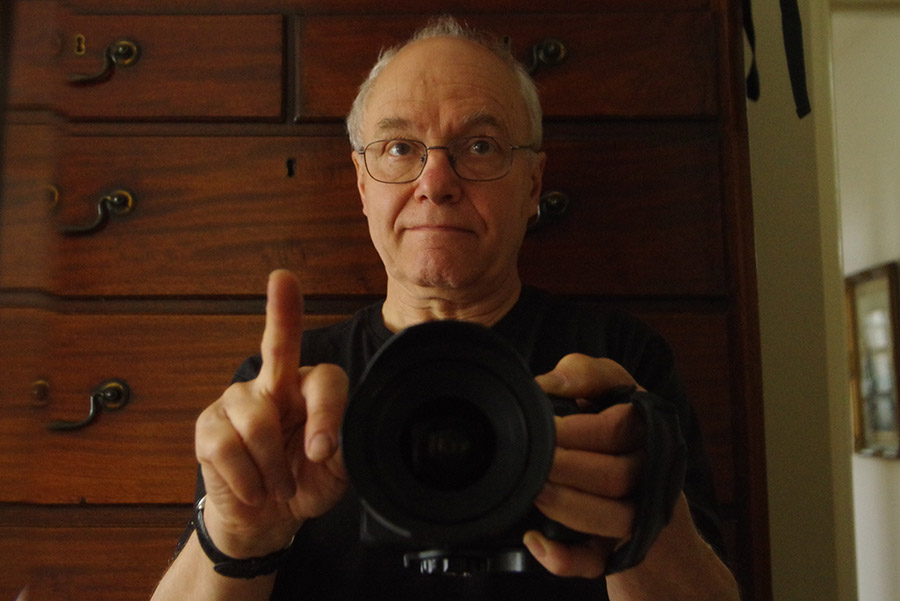
After nearly a year I’m building a second Steinbeck D. Martin Simpson took the first, and while I hadn’t received an order for a second, I loved it so much I decided to build one.
The combination of depth and ring, and the sweet instrument it became when capoed high up, were the most exciting sounds I’d heard for years; I wanted to hear them again.
As it happened, I started building in the morning and in the afternoon the phone rang. It now has a home to go to.
Here are a few progress photos.
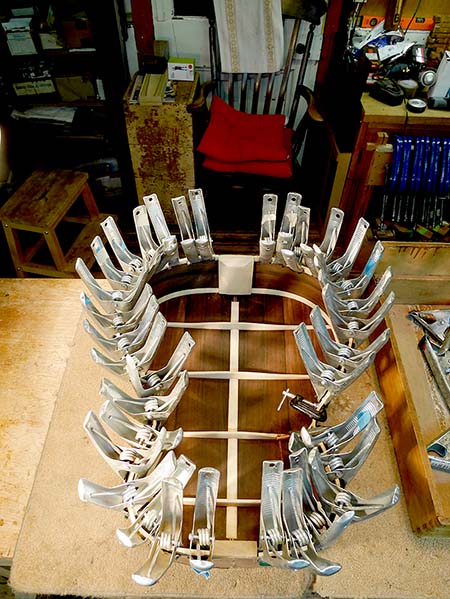 Back and sides joined and top lining clamped and gluing
Back and sides joined and top lining clamped and gluing
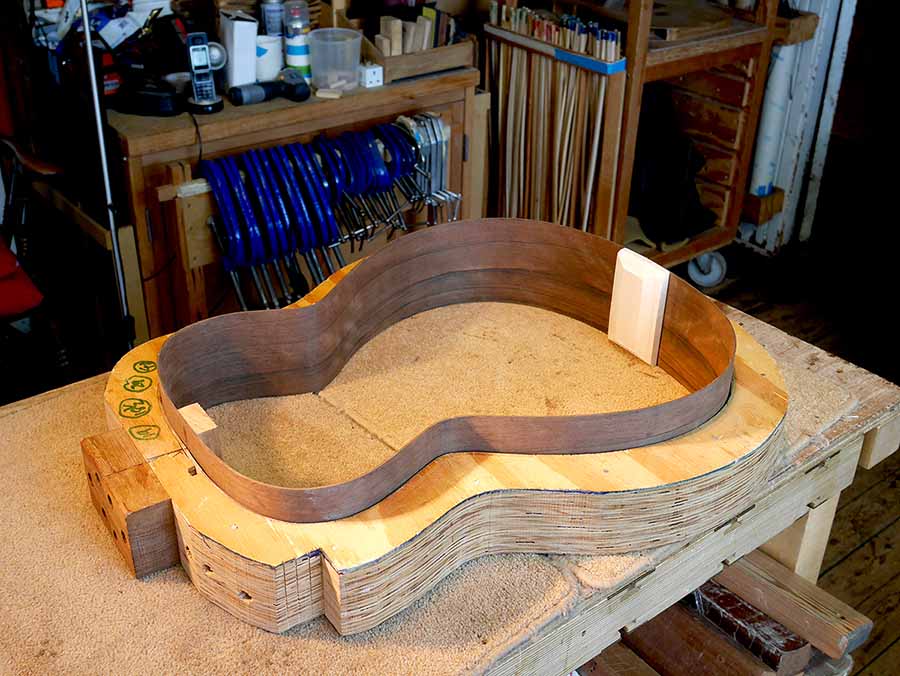 Sides bent to shape and glued to neck and tail blocks
Sides bent to shape and glued to neck and tail blocks
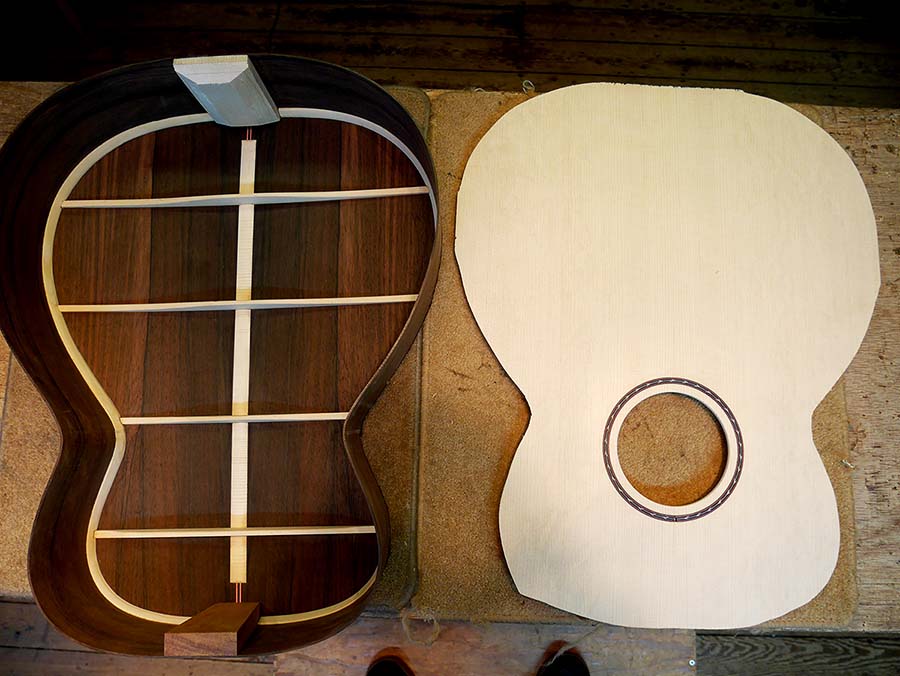 Back and sides and soundboard
Back and sides and soundboard
On Wednesday I removed the tip of my left middle finger. In nearly fifty years of building instruments I’ve had no serious injuries, and perhaps half a dozen very minor ones. This, fortunately, is very minor. But it’s a reminder that scalpels are very sharp.
When telling Roger at Fylde guitars of my mishap, he helpfully suggested that when I reach the end of the wood, I should stop cutting. Thank you Roger. But not relevant in this case, as I had not yet reached the end of the wood. After slipping with the scalpel, there was an interlude consisting of lots of swearing, bandaging and mopping up blood – amazing how much comes out of a finger, it looked like very nearly an armful. After which I finished cutting the wood. I then sanded off a small drop of blood that had landed on the inside of a soundboard, shouting ‘Out, out, damn spot’ as I did so.
I was reminded of an article I read many years ago in ‘Fine Woodworking’. A man making small maple boxes cut his finger and a drop of blood fell onto one of his boxes. He sanded and sanded, but the blood had soaked into the maple and the stain would not sand out. Frustrated, he eventually wrote next to it ‘This is my damn blood’. And this was the first box to sell.

Taken in the mirror, the damaged finger is in fact on my left hand.
 Early 6 string and recent 12 string guitars
Early 6 string and recent 12 string guitars
I’ve recently built my first 12 string guitar in a while, quickly followed by a second. The first is shown above, along with my original 6 string arch-top from 1981.
My 12 string is the same basic guitar I’ve been building for many years, but there have been a few changes. The trim is black binding with birdsfoot and black/red/black trim round the soundboard and red/white/red purfling round the back and sides. The bone saddle is now a wider single piece saddle fully compensated for the octave strings.
I’ve always been intrigued by 12 string guitars. Like many others, I had cheap one in the 60s (or in my case, a part share in one). But I couldn’t really get to grips with it and sold my share; it really is a different instrument from the 6 string and has to be approached as such. Good 12 string players can make it sound magical; it seems to me part of the the trick is learning what to leave out as compared with 6 string playing.
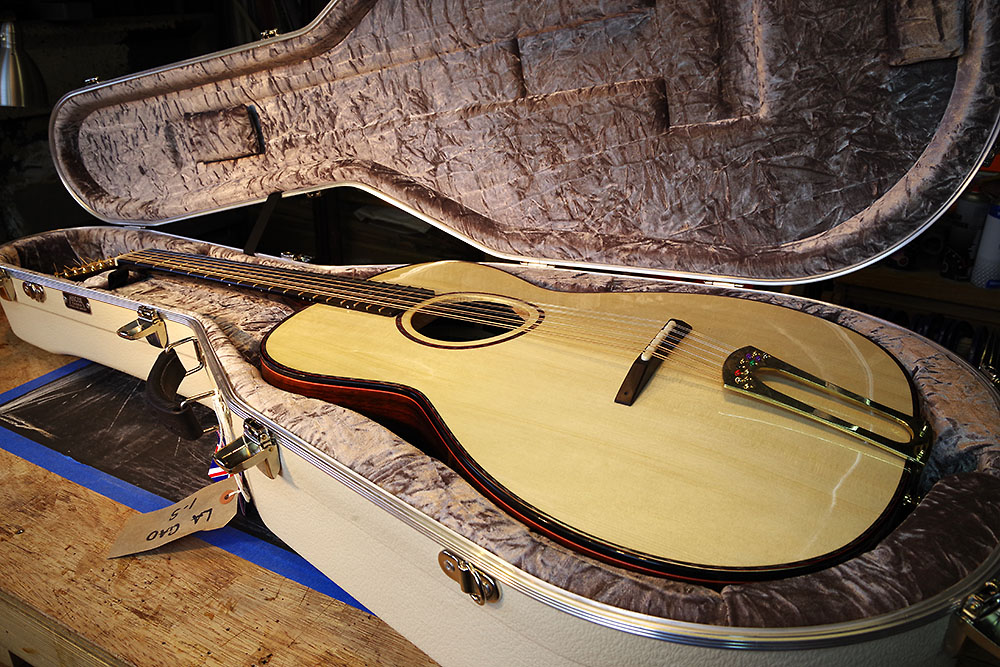 In Hiscox Artiste case
In Hiscox Artiste case
 Side showing black binding with red/white/red purfling
Side showing black binding with red/white/red purfling
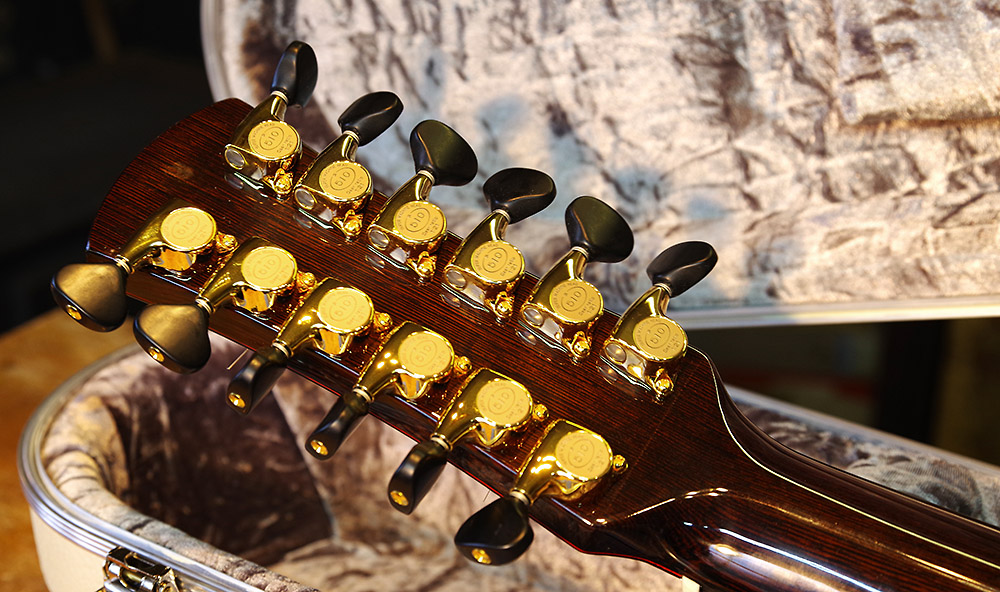 Gotoh 510 tuners – the best
Gotoh 510 tuners – the best
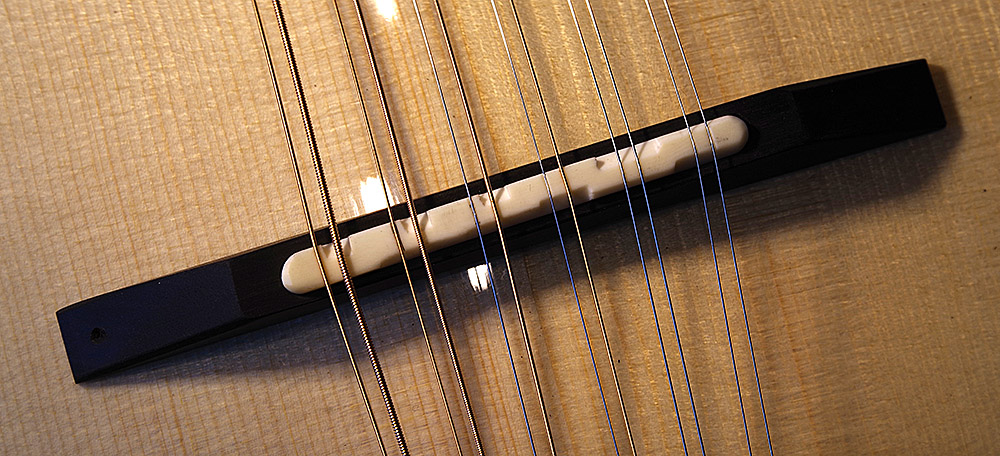 Fully compensated 12 string saddle
Fully compensated 12 string saddle
This guitar has been finished a while now, but I loved it, played it every day, and was reluctant to part with it. However, this last week I’ve traveled round most of the country and came back via Sheffield to visit Martin and see if he wanted to take it.
Martin played it for hours in the evening, and more hours in the morning, beautiful sounds drifting up to me while I was still lying in bed. When I eventually went down, he said ‘it’s astonishing’.
Martin playing it at home in Sheffield.

‘This is one of the very best guitars you’ve built’ said Martin ‘which means it’s one of the best guitars on the planet’.
The Steinbeck D is a large guitar, built on my Model 2 body, with an extended (28.5″) scale. It has African Blackwood back and sides, a figured Sitka soundboard, and a Wengé neck, the same woods as the standard smaller bodied Steinbeck.
It’s designed to be tuned one tone below standard, so fitting a capo to the second fret gives standard pitch at standard tuning and standard tension. Played open without a capo it has a magnificent depth of tone; played with a capo higher up it blossoms as a different guitar, bright and ringing.
Very little Martin plays is in standard EADGBE tuning, but each of his tunings becomes a tone lower than on a standard scale guitar. So the low C he uses in his nearly open C tuning becomes a low B#, immensely low and rich.
On the 21st of last month Massimo Raccosta organised a classical guitar recital in his home town of Verona.
The guitar to be played was one of the most famous in the world, being La Leona (The Lion) built by Torres in 1856. This guitar could be said to have influenced the whole course of classical guitar building and playing into the 20th and 21st centuries.
The guitarist was to be Wulfin Lieske, a well known and well regarded German player, and the concert was to include a Bach piece, arranged for guitar by Wulfin himself, and one of Wulfin’s own compositions.
I was interested to hear what a 150 year old guitar would sound like. An older classical guitar I heard many years ago was dull and lifeless, so while I was interested to see and hear La Leona, I wasn’t expecting it to sound good. But I was so wrong. It sounded wonderful, the bass rich and compact, the treble bright and clear, and both bass and treble notes perfectly centred.
Massimo Raccosta, who arranged the whole of the concert, is a guitarist and guitar collector with a huge collection of the best guitars from around the world, acoustic steel string, classical and electric. He has currently nearly finished a museum to house much of his collection.
Included in Massimo’s classical collection is another Torres guitar, four years younger than La Leona. This also sounded perfect, to my ears even just a little nicer even than La Leona.
Verona is famous for its food and wine. Massimo was an exceedingly generous host and we ate and drank wonderfully well.
 Massimo Raccosta
Massimo Raccosta
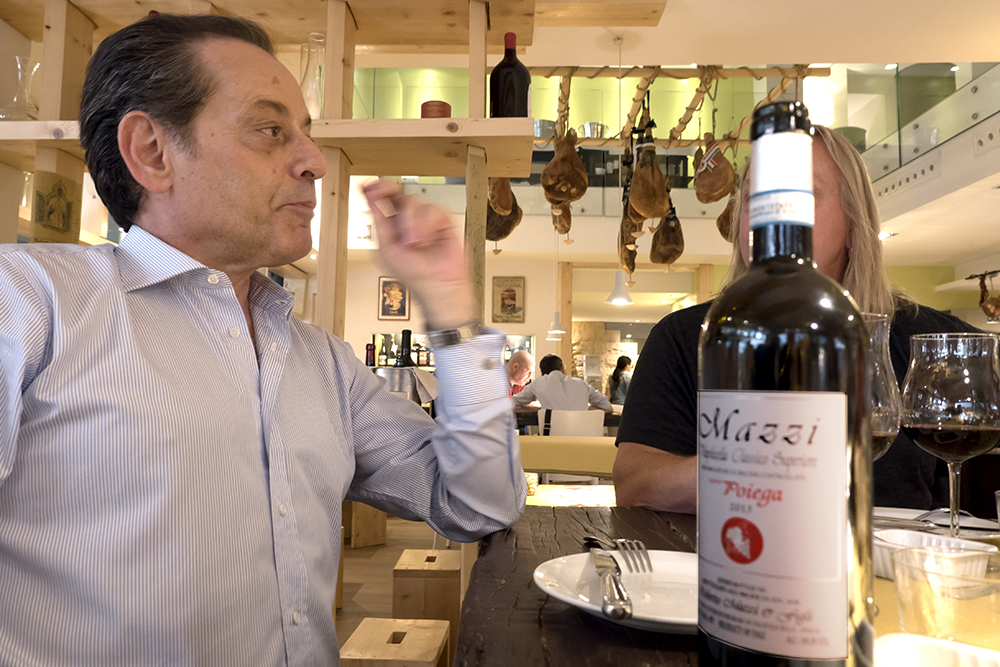
 Food and drink in Verona, my daughter Becky on the far left.
Food and drink in Verona, my daughter Becky on the far left.
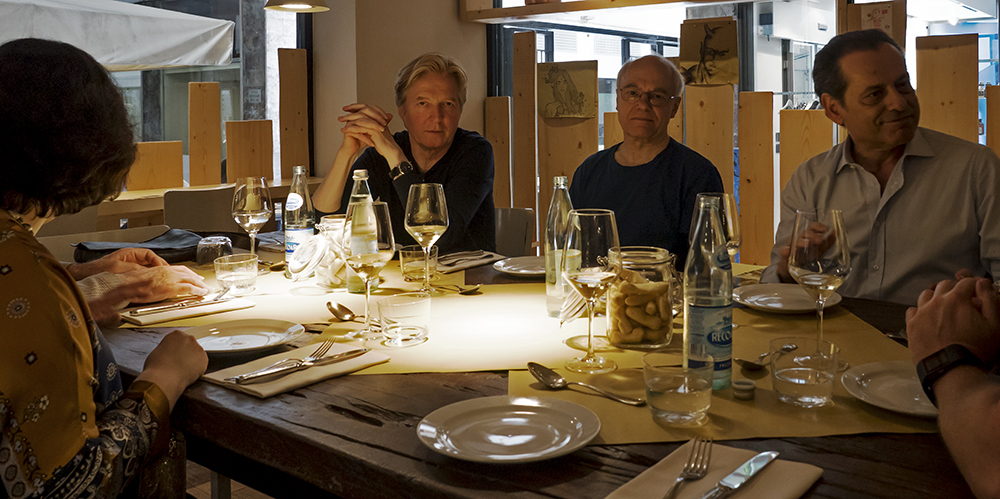 Wulfin Lieske, me and Massimo. Dr Hannen is out of picture on the right.
Wulfin Lieske, me and Massimo. Dr Hannen is out of picture on the right.
The concert
The concert was given in a magnificent small hall with elaborately painted walls to an invited audience of around fifty. These included many players and several classical makers and I was able to talk to some of these afterwards. From where I sat the acoustics were excellent; the microphone was just for recording.
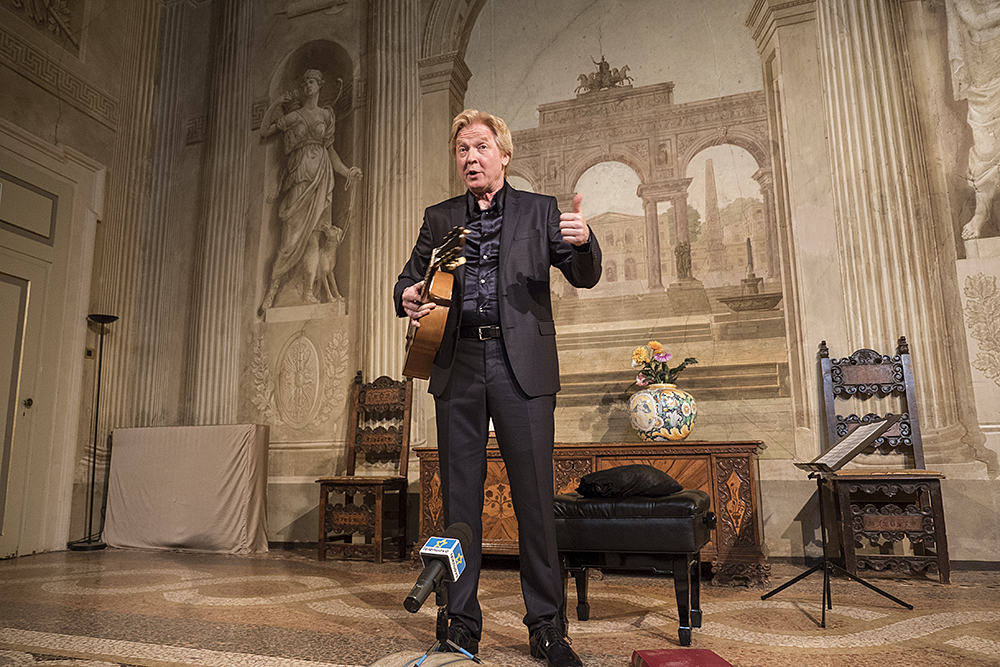 Wulfin Lieske with La Leona at the concert
Wulfin Lieske with La Leona at the concert

Dr Erhard Hannen telling us about the repair to La Leona.



Wulfin Lieske playing La Leona in Verona.
Dr Erhard Hannen gave an account to the audience of how he bought La Leona and how it was repaired.
When he tracked it down and was able to buy it, it was in poor repair with a seriously sunken soundboard. The repairman of his choice eventually used an unconventional repair method: he suspended the guitar from the ceiling (presumably by the bridge) so that the soundboard was eventually pulled up by the weight of the guitar over a period of time. The room in which it was suspended was also filled with vapour (I didn’t gather quite what vapour this was) which was intended to rejuvenate the wood and possibly stablise the repair.
There was also less drastic work carried out, including filling the string holes in the bridge and drilling new ones to give the desired 8 degrees break angle over the saddle. And some of the frets were re-positioned – I think on La Leona but possibly on another old guitar we were discussing. So many meals, so much wine, so little sleep, so much talk.
Whatever work was done on this 150 year old guitar, it sounded astonishing. Wulfin Lieske is an excellent guitarist and he and the guitar together made wonderful music.
Martin Simpson is planning to buy one of my Model 2 based D guitar (long scale, tuned a tone lower than standard – see News, page 2, 29 January 2014).
It will have African Blackwood back and sides and a bear-claw Sitka soundboard.
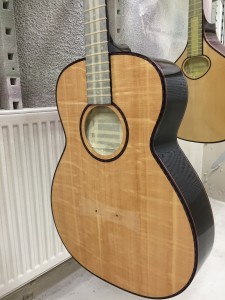 D guitar in the spraybooth
D guitar in the spraybooth
(photo – D Wilson)